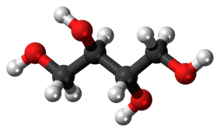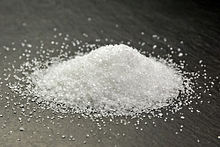
Back إريثريتول Arabic اریتریتول AZB Еритритол Bulgarian Eritritol Catalan Erythritol Czech Erythritol Danish Erythrit German Ερυθριτόλη Greek Eritritolo Esperanto Eritritol Spanish

| |

| |

| |
| Names | |
|---|---|
| IUPAC name
meso-Erythritol
| |
| Systematic IUPAC name
(2R,3S)-Butane-1,2,3,4-tetrol | |
| Other names
(2R,3S)-Butane-1,2,3,4-tetraol (not recommended)
| |
| Identifiers | |
3D model (JSmol)
|
|
| 1719753 | |
| ChEBI | |
| ChEMBL | |
| ChemSpider | |
| DrugBank | |
| ECHA InfoCard | 100.005.217 |
| E number | E968 (glazing agents, ...) |
| 82499 | |
| KEGG | |
PubChem CID
|
|
| UNII | |
CompTox Dashboard (EPA)
|
|
| |
| |
| Properties | |
| C4H10O4 | |
| Molar mass | 122.120 g·mol−1 |
| Density | 1.45 g/cm3 |
| Melting point | 121 °C (250 °F; 394 K) |
| Boiling point | 329 to 331 °C (624 to 628 °F; 602 to 604 K) |
| 61% w/w (25 °C)[1] | |
| −73.80·10−6 cm3/mol | |
| Hazards | |
| NFPA 704 (fire diamond) | |
Except where otherwise noted, data are given for materials in their standard state (at 25 °C [77 °F], 100 kPa).
| |
Erythritol (/ɪˈrɪθrɪtɒl/, US: /-tɔːl, -toʊl/)[2] is an organic compound, the naturally occurring achiral meso four-carbon sugar alcohol (or polyol).[3] It is the reduced form of either D- or L-erythrose and one of the two reduced forms of erythrulose. It is used as a food additive and sugar substitute. It is synthesized from corn using enzymes and fermentation. Its formula is C
4H
10O
4, or HO(CH2)(CHOH)2(CH2)OH.
Erythritol is 60–70% as sweet as table sugar. However, erythritol is almost completely noncaloric[4] and does not affect blood sugar[5] or cause tooth decay.[6] Japanese companies pioneered the commercial development of erythritol as a sweetener in the 1990s.
- ^ O'Neil M, ed. (2006). The Merck Index: An Encyclopedia of Chemicals, Drugs, and Biologicals (14th ed.). Merck. p. 629. ISBN 978-0-911910-00-1.
- ^ "erythritol". CollinsDictionary.com. HarperCollins. Retrieved 2023-06-29.
- ^ Rzechonek DA, Dobrowolski A, Rymowicz W, Mirończuk AM (June 2018). "Recent advances in biological production of erythritol". Critical Reviews in Biotechnology. 38 (4): 620–633. doi:10.1080/07388551.2017.1380598. PMID 28954540. S2CID 3075870.
- ^ Vasudevan DM (2013). Textbook of biochemistry for medical students. New Delhi: Jaypee Brothers Medical Publishers (P) Ltd. p. 81. ISBN 978-93-5090-530-2.
- ^ Moon HJ, Jeya M, Kim IW, Lee JK (April 2010). "Biotechnological production of erythritol and its applications". Applied Microbiology and Biotechnology. 86 (4): 1017–1025. doi:10.1007/s00253-010-2496-4. PMID 20186409. S2CID 9560435.
- ^ Kawanabe J, Hirasawa M, Takeuchi T, Oda T, Ikeda T (1992). "Noncariogenicity of erythritol as a substrate". Caries Research. 26 (5): 358–362. doi:10.1159/000261468. PMID 1468100.
